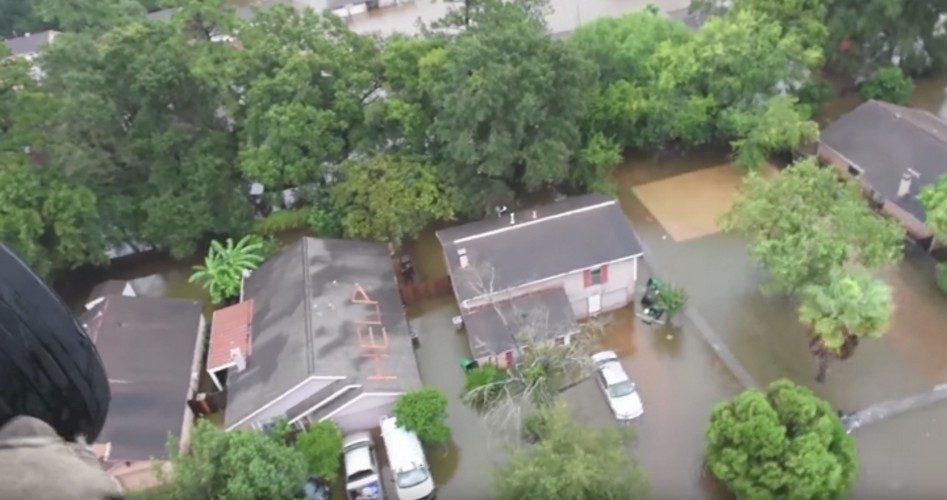
Although at first glance the enormous amount of rainfall from Hurricane Harvey would appear to be the cause of the massive flooding in Houston, Texas, one other entity is responsible for the enormity of the disaster: government.
“Storms are natural events, but floods are usually man-made disasters,” writes Politico’s Michael Grunwald. “That’s because flood damage depends not only on how much water is involved, but on how many people and structures are in its path and how prior human intervention had affected that path. Government policies affect all three of those variables, which is one reason why ‘500-year floods’ — which are supposed to have a 1-in-500 chance of occurring in a particular place in a particular year — are becoming so common.”
With the arrival of Hurricane Harvey, Houston has experienced three “500-year-floods” in the past three years, according to Grunwald, including two small storms that “did so much property damage they made the list of the 15 highest-priced floods in U.S. history.”
The city, located at the confluence of two bayous, was prone to flooding from its founding in 1836, according to the Harris County Flood Control District. Settlers drained the land, but that didn’t prevent 16 major floods over the next century.
Rather than move to less flood-prone territory, residents turned to the government for help. In 1937, the flood-control district was created; working with the U.S. Army Corps of Engineers, it set about protecting Houston from further deluges. Still, says the district, “close to 30 damaging floods have occurred in the area, resulting in hundreds of millions of dollars in damages in just under 70 years.” Tropical Storm Allison, in 2001, inflicted $5 billion worth of damage. (The Army Corps of Engineers’ levees along the Mississippi River and the Gulf Coast have also been responsible for many other floods, including those from Hurricane Katrina in 2005.)
Meanwhile, federal flood insurance has encouraged the “explosive growth of low-lying riverine and coastal development,” notes Grunwald, “which has had the double effect of increasing floods (by replacing prairies and other natural sponges that hold water with pavement that deflects water) while moving more property into the path of those floods.”
“Created in 1968,” he explains, “the National Flood Insurance Program was actually supposed to help prevent risky development.” However, like most other government programs, it has accomplished the exact opposite of its stated aims:
Its complex rules required new construction within designated 100-year floodplains to meet higher flood-proofing standards and required “substantially damaged” properties that received claims worth half their value to be relocated or elevated. But most of the program’s 100-year flood maps are woefully obsolete, relocation almost never happens, and Uncle Sam has continued to cut multiple checks for repetitive losses. A recent Pew Foundation study found that … about 1 percent of insured properties have sustained repetitive losses, accounting for more than 25 percent of the nation’s flood claims…. The government routinely dishes out more in claims than it takes in through premiums, and the program has gradually drifted deeper and deeper into debt.
That the insurance program exacerbates the problem of development in flood-prone areas has been known for decades. But Congress, responding to constituents, developers, and real-estate agents, has consistently refused to reform the program to discourage such development (by, for instance, increasing premiums) or at least mitigate taxpayers’ exposure to large, repeated payouts. Indeed, after lawmakers managed to pass a decent reform bill in 2012, they turned around and undid most of it just two years later. The program is up for renewal this year, but the disaster in Houston is likely to scuttle any attempts at reform. As Larry Larson, senior policy director for the Association of State Floodplain Managers, told Grunwald, “The floods have gotten worse, but the politics haven’t gotten better.”
The best thing to do with the program, of course, is to repeal it. It’s unconstitutional, and it unjustly transfers the risks of living in flood-prone areas from residents of those areas to the entire taxpaying populace.
Beyond that, a complete rethinking of government flood-control efforts is in order. Changes in policy could spare millions of Americans from future deluges of water and taxpayers from a growing flood of red ink.
Photo: Screen-grab from U.S. Navy “Hurricane Harvey Search and Rescue” video



